Authors: Neal Hughes, David Galeano and Steve Hatfield-Dodds

The current drought across much of eastern Australia has demonstrated the dramatic effects that climate variability can have on farm businesses and households. The drought has also renewed longstanding discussions around the emerging effects of climate change on agriculture, and how governments can best help manage climate risk. This article provides some insight into these issues by examining the effects of recent climate variability on Australian farms.
[expand all]
Australian farmers face significant climate and price risk
Australian farmers face a wide range of risks, but they are particularly exposed to variability in climate and commodity prices. Figure 1 shows annual average farm profits since 1988–89, along with variations in rainfall and commodity prices.
The most profitable years for farmers tend to be those with high rainfall and favourable prices, such as 2016–17, while the least profitable tend to be drought years with unfavourable prices, such as 2006–07. However, these relationships are complex with many other factors, such as changes in technology and farming practices, also influencing profits over time.
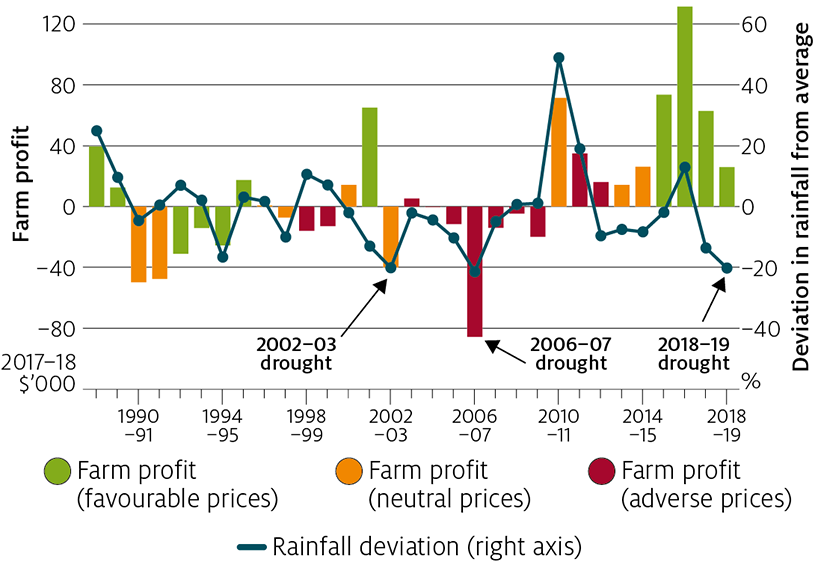
Source: ABARES Australian Agricultural and Grazing Survey (AAGIS), Bureau of Meteorology.
The 2018–19 drought
Much of eastern Australia experienced severe drought conditions during 2018-19. Current ABARES estimates show farms in drought-affected NSW recorded large falls in profit in 2018–19. However, average farm profits in less drought-affected regions (such as WA) increased due to high commodity prices for both grain and livestock. Nationally, average farm returns decreased in 2018–19 but remained above levels observed during the 2002–03 drought (Figure 1).
For the latest information on the effects of drought into 2019–20 see ABARES Farm Survey, Weekly Climate and Australian Crop reports.
Measuring the effects of climate variability on farm profits
The effects of climate on farms are complex and can vary greatly across locations and farm types. To account for this, ABARES has developed a model based on more than 30 years of data, farmpredict, which can identify the different effects of price and climate variability and other factors on Australian broadacre farms (more detail is provided at the end of this article).
Figure 2 and Figure 3 present simulation results showing the effects of climate variability on the profits of typical (average) Australian cropping, mixed and beef farms. These results show the effects of historical climate variability (1950 to 2019) on the profits of current farms, holding all other factors constant, including commodity prices, farm size, and management practices.
Cropping farms generally face greater climate risk than beef farms, while mixed-cropping livestock farms sit in-between these extremes (Figure 2). There is a trade-off between risk and return: cropping farms face higher risk but also generate higher average returns.


Source: ABARES farmpredict
These different effects of climate reflect the nature of cropping and livestock farm production systems, as shown in Figure 3. For a typical cropping farm, profit decreases from around $230,000 in a ‘typical year’, down to a loss of $125,000 in a ‘dry year’ (a 1 in 10 poor climate year) (Figure 3). These losses in dry years are driven by large reductions in crop output, due to lower crop yields and area planted. Lower crop revenues (down by about $370,000) are slightly offset by reductions in input costs (Figure 3).
For a typical Australian beef farm, profit falls from $60,000 in a ‘typical year’ down to a loss of $5,000 in a ‘dry year’ (Figure 3). On beef farms, drought has a smaller effect on revenue in the short-term, because in dry years farmers increase the quantity of livestock sold. These increased sales help to offset reductions in farm prices received for livestock (for a fixed national price) due to the effects of drought on livestock quality (Figure 3). However, drought years also reduce herd sizes, due to higher sales, deaths, and lower birth rates. This results in negative profits when the value of the reduced herd size is accounted for, as well as lower farm cash income over the longer-term.

Source: ABARES farmpredict
How do farmers manage risk?
Farmers mitigate risk with their management practices
Farmers limit the effects of climate and price risk through active management. For example, in the cropping sector farmers make use of weather and commodity price forecasts, and reduce crop area planted and inputs applied (such as fertiliser) when drought conditions or poor output prices are more likely. Livestock farms prepare for drought by holding stocks of grain and hay and reducing livestock herd size. More generally, diversification—undertaking a variety of crop and livestock activities, or farming in multiple locations—can help farmers reduce their risk exposure.
Improvements in technology and management practices over time can also help mitigate risk. For example, past ABARES research has shown that cropping farms have reduced the sensitivity of yields and productivity to dry conditions over the last decade (Hughes et al. 2017). These gains are due in part to newer conservation tillage practices which enable farms to better conserve soil moisture.
Farmers absorb risk through off-farm income and high equity levels
Despite farmers best efforts they remain exposed to significant climate and price risk. Two key ways farmers manage this residual risk are by holding a high level of equity (i.e., a low level of debt) and maintaining sources of off-farm income. For many farms, these strategies are vital both to ensure the long-term survival of the farm business and to minimise variation in household income.
The importance of these strategies depends greatly on the size and nature of the farm. Figure 4 shows the effect of climate variability on the profitability of typical ‘small’, ‘medium’ and ‘large’ Australian cropping and beef farms. As previous research has shown, smaller farms are less profitable on average, with lower rates-of-return (see Boult and Jackson 2019, Jackson et al. 2018). Small farms are also much more likely to experience low cash income and negative profits during drought years.
Farms generally maintain higher equity than comparable non-farm businesses and households, with smaller farms maintaining higher equity ratios than large farms (Jackson et al. 2018). Small farms also have a larger share of household income coming from off-farm sources, averaging 50%, compared with 6% for large farms (based on ABARES AAGIS data). These strategies contribute to farm businesses maintaining high survival rates relative to many other sectors of the Australian economy, despite their highly variable profits (Jackson et al. 2018).
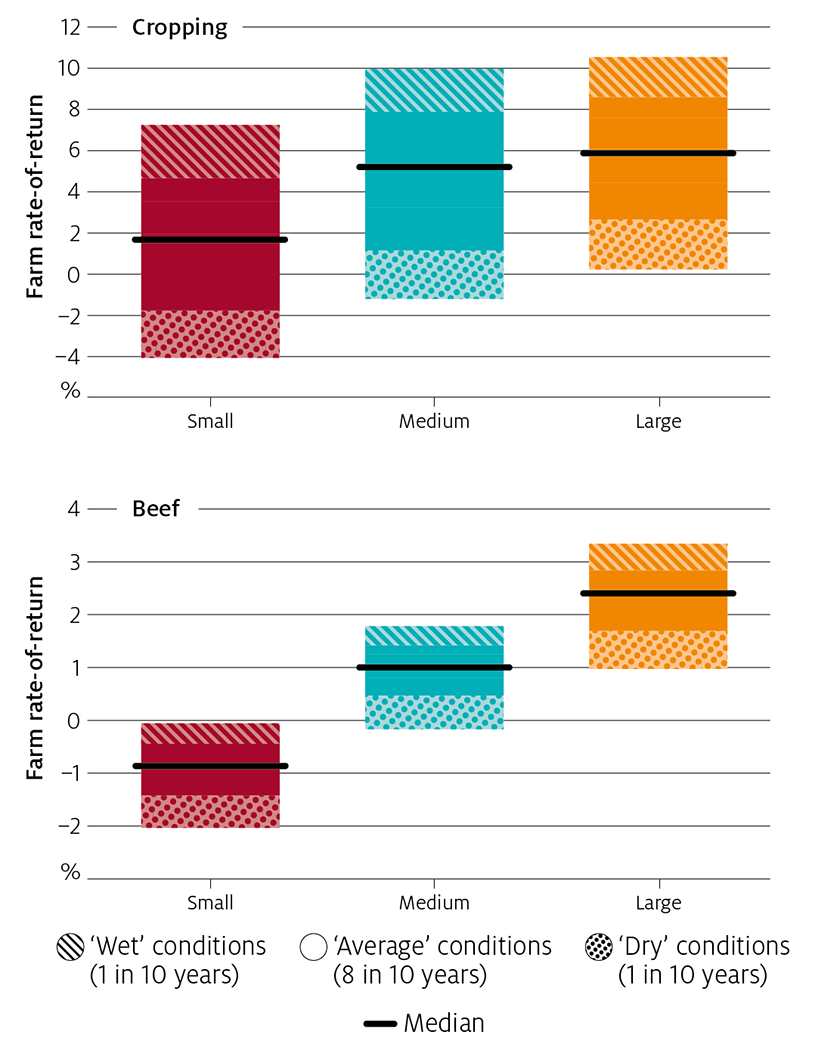
Source: ABARES farmpredict.
How can governments help to manage farm climate risk?
From drought relief to drought preparedness and self-reliance
Australian drought policy faces an almost unavoidable dilemma: that providing relief to farm businesses and households in times of drought risks slowing industry structural adjustment and innovation. Adjustment, change and innovation are fundamental to improving agricultural productivity; maintaining Australia’s competitiveness in world markets; and providing attractive and financially sustainable opportunities for farm households. In some cases, well-intentioned policies can also disadvantage farmers who have been better prepared—or luckier—than farmers who are provided assistance and relief, diluting management incentives and raising difficult equity issues.
Previous ABARES research has shown that structural adjustment accounts for around half of productivity growth in the sector (Sheng et al. 2015). This includes farm consolidation, which has seen the number of farms in Australia halve over the last 60 years, while average farm size has increased—supporting diffusion of improved management practices, as well as providing increased economies of scale, and increasing farm incomes.
For these reasons, the strategic intent of drought policy has shifted away from seeking to protect and insulate farmers, towards the promotion of farmer drought preparedness and self‑reliance (DA 2019). This shift reflects increased awareness of the undesirable side-effects of previous approaches to drought support (see PC 2009, AFI 2019). In particular, the 1992 National Drought Policy and 2018 National Drought Agreement sets out that drought programs should focus on supporting farm households, such as through the Farm Household Allowance (FHA) scheme, and avoid providing support for farm businesses.
Policy needs to get ahead of the curve
Supporting farm households experiencing hardship is legitimate and important, but for the long term health of the farm sector this needs to be done in ways that promote resilience and improved productivity, and allow for adjustment and change.
The best options for reconciling the drought policy dilemma focus on boosting the resilience of farm businesses and households to future droughts and climate variability, including through policy action and investment when farmers are not in drought. The Government’s Future Drought Fund to support research and innovation is a good example of this approach. However, while such investments in future resilience are crucial, they do not provide relief to farm households experiencing hardship today.
The development of insurance markets could help
One promising option is the development of viable weather insurance markets—where farmers pay premiums sufficient to cover costs over time.
Unfortunately, while Australia has effective insurance markets for some farm risks, particularly hail and fire, markets for other climate risks, particularly drought, remain more limited. Information problems continue to hamper standard drought insurance products (such as Multi-Peril Crop Insurance) both in Australia and internationally, leading to high premiums and limited uptake by farmers (see Hatt et al. 2012).
Index-based or parametric insurance provides an alternative approach, where payouts are based on weather data rather than actual farm damages. For example, a farmer may receive a payout when rainfall falls below an agreed threshold. This helps reduce the cost of insurance, as providers do not need to do detailed farm assessments or ongoing monitoring. However, parametric weather insurance still faces some difficult technical challenges and has seen limited application in Australia to date (see Hughes 2018).
Insurance is an important area for research, as it could provide farmers new options for self-managing climate risks. Numerous reviews have examined options for government to support weather insurance in Australia (AFI 2019, Deloitte 2017, Hatt et al. 2012), including investments in better data (both weather and farm data). The development of better data sets and tools to support drought insurance, is a subject of ongoing research at ABARES including a collaborative project with the ABS (see the end of this report).
Changes in climate are affecting Australian farms
Higher temperatures and lower winter rainfall
Australian average temperatures have increased by about 1oC since 1950 (BOM and CSIRO 2018). Recent decades have also seen a trend towards lower average winter season rainfall in the southwest and southeast of Australia (Figure 5, BOM and CSIRO 2018). This drying trend is the largest sustained change in Australian rainfall since records began (BOM and CSIRO 2018) and it is linked with atmospheric changes associated with global warming (Cai and Cowan 2013, Cai, Cowan and Thatcher 2012, BOM and CSIRO 2018, CSIRO 2012).
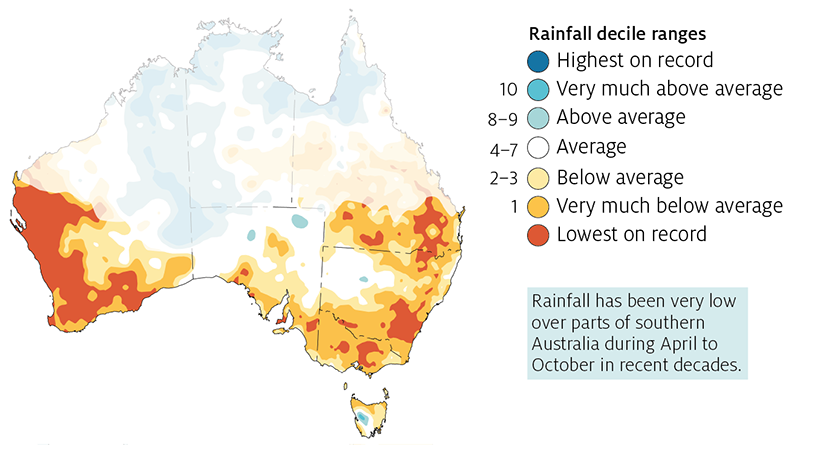
Source: Bureau of Meteorology 2018
While some clear trends in rainfall are beginning to emerge, there is still significant uncertainty over long-term future rainfall. Although global climate models generally predict a decline in winter season rainfall across southern Australia, and more time spent in drought (BOM and CSIRO 2018), the likely magnitude of these effects is uncertain (CSIRO and BOM 2015).
Recent changes in climate have negatively affected farm profitability
Previous ABARES research has shown that changes in climate conditions over the last 20 years have had an adverse effect on the productivity of Australian cropping farms (Hughes et al. 2017). ABARES most recent analysis finds that changes in climate over the period 2000 to 2019 (relative to the period 1950 to 1999) have had a negative effect on the profitability of broadacre farms in Australia, including both cropping and livestock sectors, as shown in Figure 6, Figure 7, and Table 1.
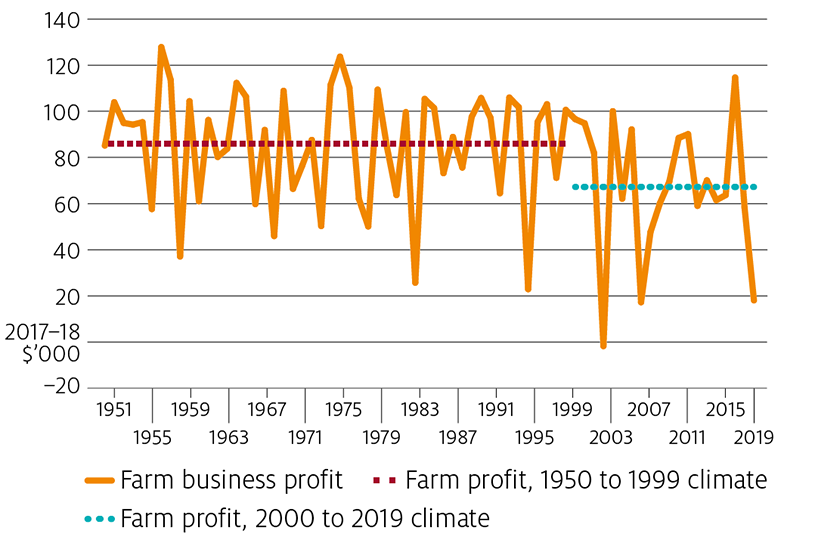
Source: ABARES farmpredict, Hughes et al. 2019.
Controlling for non-climate factors, we find changes in climate since 2000 have reduced average annual broadacre farm profits by 22%, or around $18,600 per farm (see Table 1).

reference period 1949–50 to 2018–19. Farm business profit is calculated at market prices for all inputs and outputs, including unpaid family labour, as well as changes in the value of stocks (including inventory and livestock). Pie chart percentages do not add due to rounding error.
Source: ABARES farmpredict
These effects have been most pronounced in the cropping sector, reducing average profits by 35%, or $70,900 for a typical cropping farm. This includes a negative effect on cropping revenue of 8% or around $82,000 per cropping farm. Nationally, this represents an average loss in revenue (gross value of production) for the broadacre cropping industry of around $1.1 billion a year (based on 2015–16 to 2017–18 production levels).
While beef farms have been less affected overall, with a reduction in average profits of 5%, some beef farming regions have been affected more than others, particularly south-western Queensland (Figure 7). The analysis finds that overall broadacre farming has been adversely effected in all states and territories, except the Northern Territory (see Table 1).
Similar to past ABARES research (Hughes et al. 2017) this study finds evidence of adaptation and management practice change helping to reduce the sensitivity of farms to dry conditions over time. Our results suggest that without these gains the effects of the post-2000 climate would have been larger (26% average decline in profit for all broadacre farms and 49% for cropping farms under 1990 technology). This suggests the impacts of this climate shift on profits would have been $26,700 larger for an average cropping farm without adaptation.
| Average annual broadacre farm profit | Difference in profit | |||
|---|---|---|---|---|
| Climate conditions 1950–1999 |
Climate conditions 2000–2019 |
% | $ | |
| State | ||||
| NSW | 66,100 | 49,300 | –25.5 | –16,900 |
| Vic. | 36,200 | 22,800 | –37.1 | –13,400 |
| Qld | 75,500 | 64,900 | –14.1 | –10,700 |
| SA | 101,700 | 90,300 | –11.2 | –11,400 |
| WA | 226,000 | 167,600 | –25.8 | –58,300 |
| TAS | 74,300 | 69,000 | –7.1 | –5,300 |
| NT | 769,200 | 835,900 | 8.7 | 66,800 |
| Industry | ||||
| Cropping | 201,000 | 130,100 | –35.3 | –70,900 |
| Mixed | 106,200 | 84,600 | –20.3 | –21,600 |
| Sheep | 33,400 | 27,300 | –18.2 | –6,100 |
| Beef | 50,300 | 48,000 | –4.6 | –2,300 |
| Sheep-Beef | 79,600 | 72,800 | –8.6 | –6,800 |
| All farms | 85,900 | 67,200 | –21.7 | –18,600 |
Notes: Difference in simulated weighted average farm business profit for broadacre farms, in 2018–19 dollars, assuming current farms and commodity prices (2015–16 to 2017–18), between previous historical climate conditions (1949–50 to 1998–99) and observed climate in the last two decades (1999–2000 to 2018–19).
Source: ABARES farmpredict.
Climate risk has also increased in recent decades
Climate conditions during the post-2000 period have not only affected average farm profits, they have also contributed to increased risk in terms of more variable cash income and profitability, particularly for cropping farms. Figure 8 shows the distribution of farm rate-of-return for a typical Australian cropping farm under observed climate conditions before and after the year 2000. These results show an increase in downside risk, with the chance of very low profits (below a 2% rate of return) more than doubling since 2000.

Source: ABARES farmpredict
ABARES research on climate variability
Data analysis and models which improve our understanding of the effects of climate variability on farms have an important role to play in informing potential government and private sector responses to drought and climate variability and change. ABARES has a number of ongoing projects in this area.
ABARES is developing the capability to use the farmpredict model to explore and assess long-term climate projection scenarios for Australian broadacre farms. These scenarios will assess how current farms with current technology would perform under long-term future climate conditions. Such results will help indicate the challenges and opportunities facing agricultural regions, industries and farm types under different future climate change scenarios.
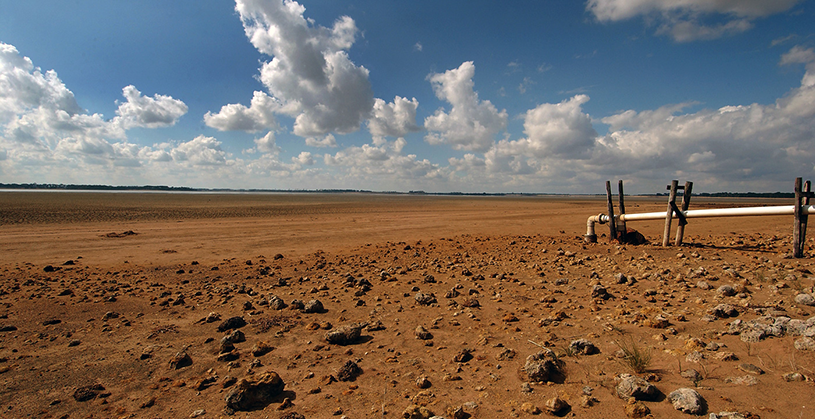
ABARES is also applying farmpredict to measure the sensitivity of broadacre farms to drought and how this has changed over time, providing insights that can help inform future investments in farm drought resilience. Work is also underway to link farmpredict to seasonal climate forecasts and ABARES commodity price forecasts, to generate short-term forecasts for Australian farm production and profit.
In related work, ABARES is partnering with the Australian Bureau of Statistics (ABS) to develop a new Australian farm database, combining information from the ABS agricultural census with business financial data from the ABS Business Longitudinal Analysis Data Environment (BLADE). A first application of this capability will be to design and test potential new index-based farm insurance products.
What is farmpredict?
ABARES farmpredict (Hughes et al. 2019) is a statistical model developed using historical farm data from ABARES Australian Agricultural and Grazing Industry Survey (AAGIS) along with climate data from the Bureau of Meteorology (BoM). The farmpredict model draws on over 40,000 farm observations to predict, or simulate, over 50 physical and financial farm variables. This includes simulation of the production of farm outputs (e.g., wheat, beef cattle, wool etc.), the use of farm inputs (e.g., fuel, fertiliser, labour etc.) and changes in farm stocks (e.g., livestock and grain), given information on farm fixed inputs (e.g., land and capital), input and output prices and prevailing climate conditions (Figure 9). farmpredict provides coverage of all major broadacre farming regions and industries, including extensive cropping and livestock (beef and sheep) and mixed farming types.
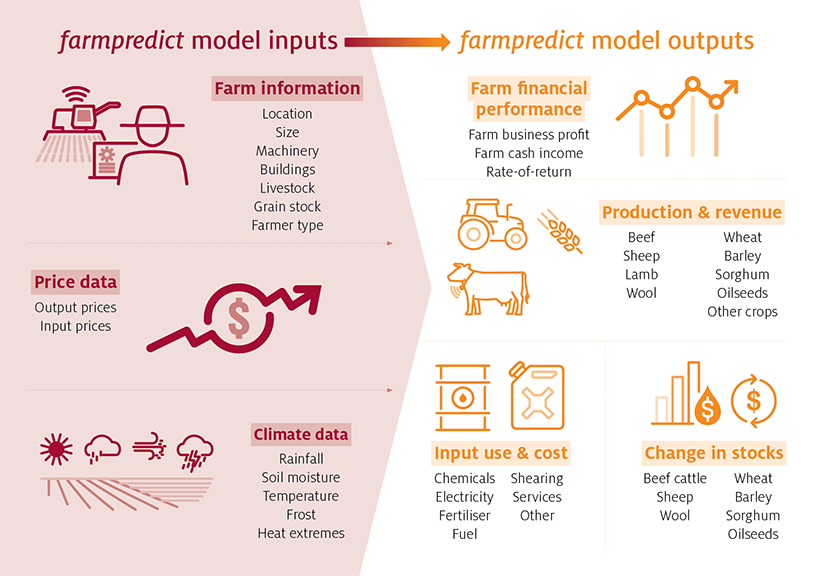
References
Australian Bureau of Statistics (ABS) 2018a, Counts of Australian Businesses, including Entries and Exits, Jun 2013 to Jun 2017, cat. no. 8165.0, Table 2, viewed 13 February 2019, www.abs.gov.au/AUSSTATS/abs@.nsf/DetailsPage/8165.0Jun%202013%20to%20Jun%202017?OpenDocument
Australian Bureau of Statistics (ABS) 2018b, Australian System of National Accounts, 2017‑18, cat. no. 5204.0, Table 5, viewed on 13 February 2019, www.abs.gov.au/AUSSTATS/abs@.nsf/DetailsPage/5204.02017-18?OpenDocument
AEGIC 2016, ‘New Australian climate developing’, Australian Export Grains Innovation Centre, Perth, http://aegic.org.au/new-australian-climate-developing
Australian Farm Institute (AFI), 2019, ‘Australian agriculture an increasingly risky business’, www.farminstitute.org.au/publications-1/research-reports/research-report-australian-agriculture-an-increasingly-risky-business
Boult, C. and Jackson, T., 2019, Disaggregating farm performance statistics by size, 2017–18, www.agriculture.gov.au/abares/research-topics/productivity/related-research/disaggregating-farm-size
Bureau of Meteorology and CSIRO (2018), State of the climate report 2018, www.bom.gov.au/state-of-the-climate
CSIRO (2012) Climate and water availability in south-eastern Australia: A synthesis of findings from Phase 2 of the South Eastern Australian Climate Initiative (SEACI), CSIRO, Australia, September 2012, pp. 41.
CSIRO and Bureau of Meteorology 2015, Climate Change in Australia Information for Australia’s Natural Resource Management Regions: Technical Report, CSIRO and Bureau of Meteorology, Australia www.climatechangeinaustralia.gov.au/en/publications-library/technical-report/
Cai, W & Cowan, T 2013, ‘Southeast Australia autumn rainfall reduction: A climate-change-induced poleward shift of ocean–atmosphere circulation’, Journal of Climate, vol. 26, no. 1, pp. 189–205.
Cai, W., Cowan, T. & Thatcher, M. 2012 Rainfall reductions over Southern Hemisphere semi-arid regions: the role of subtropical dry zone expansion., Scientific Reports
Department of Agriculture, Water and the Environment (DA), 2019, ‘History of drought policy and programs’ www.agriculture.gov.au/ag-farm-food/drought/drought-policy/history
Hatt, M., Heyhoe, E., Whittle, L., 2012, Options for insuring Australian agriculture, ABARES report www.agriculture.gov.au/ag-farm-food/drought/assistance/mfrp/agricultural-insurance-feasibility/options
Hattfield-Dodds (2019) Droughts, extreme weather and empowered consumers mean tough choices for farmers, https://theconversation.com/droughts-extreme-weather-and-empowered-consumers-mean-tough-choices-for-farmers-112857
Hughes, N, Lawson, K, & Valle, H 2017, Farm performance and climate: climate adjusted productivity on broadacre cropping farms, Australian Bureau of Agricultural; Resource Economics; Sciences.
Hughes, N. (2018) Better data would help crack the drought insurance problem, https://theconversation.com/better-data-would-help-crack-the-drought-insurance-problem-106154
Hughes, N. 2017, Australian farmers are adapting to climate change, viewed on 15/02/2019 from https://theconversation.com/australian-farmers-are-adapting-to-climate-change-76939
Hughes, N. and Hattfield-Dodds, S. (2018) Helping farmers in distress doesn’t help them be the best: the drought relief dilemma, https://theconversation.com/helping-farmers-in-distress-doesnt-help-them-be-the-best-the-drought-relief-dilemma-105281
Hughes, N., Soh, W., Boult, C., Lawson, K., Donoghoe, M., Valle, H., Chancellor, W. 2019, ‘farmpredict: A micro-simulation model of Australian farms’, ABARES working paper, https://www.agriculture.gov.au/abares/research-topics/working-papers/farmpredict.
Jackson, T, Zammit, K & Hatfield-Dodds, S 2018, Snapshot of Australian Agriculture, Australian Bureau of Agricultural and Resource Economics and Sciences, Canberra.
Martin, P. and Topp, V. (2019), Farm performance: broadacre and dairy farms, 2016–17 to 2018–19, www.agriculture.gov.au/abares/research-topics/surveys/farm-performance
Productivity Commission (PC), 2009, Government drought support, Public inquiry, www.pc.gov.au/inquiries/completed/drought
Sheng, Y., Jackson, T., & Davidson, A. (2015), Resource reallocation and its contribution to productivity growth in Australian broadacre agriculture. Canberra: Australian Bureau of Agricultural and Resource Economics and Sciences, https://daff.ent.sirsidynix.net.au/client/en_AU/search/asset/1027266/0
Download this Insights paper
ABARES Insights: Analysis of the effects of drought and climate variability on Australian farms
